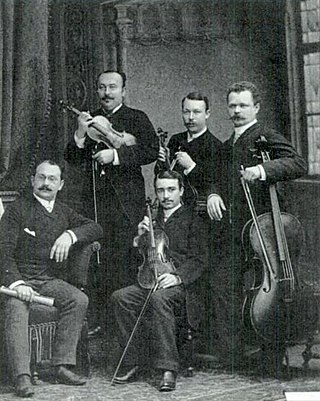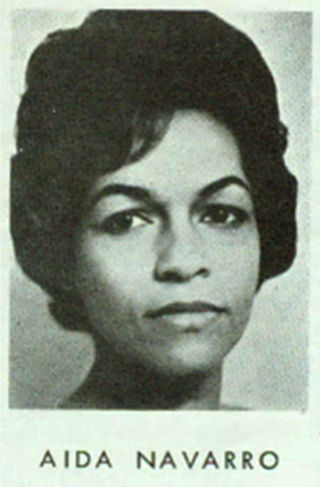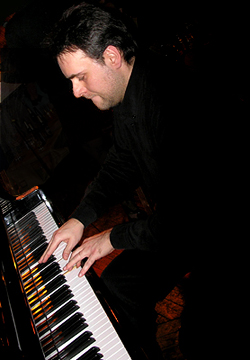Related Research Articles

A musical ensemble, also known as a music group or musical group, is a group of people who perform instrumental and/or vocal music, with the ensemble typically known by a distinct name. Some music ensembles consist solely of instrumentalists, such as the jazz quartet or the orchestra. Other music ensembles consist solely of singers, such as choirs and doo-wop groups. In both popular music and classical music, there are ensembles in which both instrumentalists and singers perform, such as the rock band or the Baroque chamber group for basso continuo and one or more singers. In classical music, trios or quartets either blend the sounds of musical instrument families or group instruments from the same instrument family, such as string ensembles or wind ensembles. Some ensembles blend the sounds of a variety of instrument families, such as the orchestra, which uses a string section, brass instruments, woodwinds, and percussion instruments, or the concert band, which uses brass, woodwinds, and percussion.

Astor Pantaleón Piazzolla was an Argentine tango composer, bandoneon player, and arranger. His works revolutionized the traditional tango into a new style termed nuevo tango, incorporating elements from jazz and classical music. A virtuoso bandoneonist, he regularly performed his own compositions with a variety of ensembles. In 1992, American music critic Stephen Holden described Piazzolla as "the world's foremost composer of Tango music".

Chamber music is a form of classical music that is composed for a small group of instruments—traditionally a group that could fit in a palace chamber or a large room. Most broadly, it includes any art music that is performed by a small number of performers, with one performer to a part. However, by convention, it usually does not include solo instrument performances.

In classical music, a piano quintet is a work of chamber music written for piano and four other instruments, most commonly a string quartet. The term also refers to the group of musicians that plays a piano quintet. The genre flourished during the nineteenth century.

The music of Brazil encompasses various regional musical styles influenced by European, American, African and Amerindian forms. Brazilian music developed some unique and original styles such as forró, repente, coco de roda, axé, sertanejo, samba, bossa nova, MPB, gaucho music, pagode, tropicália, choro, maracatu, embolada, frevo, brega, modinha and Brazilian versions of foreign musical styles, such as rock, pop music, soul, hip-hop, disco music, country music, ambient, industrial and psychedelic music, rap, classical music, fado, and gospel.
A quintet is a group containing five members. It is commonly associated with musical groups, such as a string quintet, or a group of five singers, but can be applied to any situation where five similar or related objects are considered a single unit.
Roque Cordero was a Panamanian composer.
Derek Bermel is an American composer, clarinetist and conductor whose music blends various facets of world music, funk and jazz with largely classical performing forces and musical vocabulary. He is the recipient of various awards including a Guggenheim Fellowship and the American Academy in Rome's Rome Prize awarded to artists for a year-long residency in Rome.

Ariano Vilar Suassuna was a Brazilian playwright and author. He was the driving force behind the creation of the Movimento Armorial. He founded the Student Theater at Federal University of Pernambuco. Four of his plays have been filmed, and he was considered one of Brazil's greatest living playwrights of his time. He was also an important regional writer, doing various novels set in the Northeast of Brazil. He received an honorary doctorate at a ceremony performed at a circus. He was the author of, among other works, the Auto da Compadecida and A Pedra do Reino. He was a staunch defender of the culture of the Northeast, and his works dealt with the popular culture of the Northeast.

Jan Dumée is a Dutch rock/jazz guitar player, composer and record producer.

Henrique José Pedro Maria Carlos Luis Oswald was a Brazilian composer and pianist.
Paleka is a Portuguese percussionist in the genres of jazz, contemporary music, and world music.
Traditionally a clarinet quintet is a chamber musical ensemble made up of one clarinet, plus the standard string quartet of two violins, one viola, and one cello. Now the term clarinet quintet can refer to five B♭ clarinets; four B♭ clarinets and a bass clarinet; three B♭ clarinets and two bass clarinets; one E♭ clarinet, two B♭ clarinets, and two bass clarinets; or one E♭ clarinet, two B♭ clarinets, one E♭ alto clarinet, and one bass clarinet. The term is also used to refer to a piece written for one of these ensembles.
Enrico Chapela is a Mexican contemporary classical composer, whose works have been played by multiple major orchestras and has been commissioned to compose for institutions such as the Los Angeles Philharmonic, the National Center for the Performing Arts (Beijing) and the Festival Internacional Cervantino. His work is influenced by modern popular musical styles such as rock and electronic, as well as Mexican popular culture.

Antonio Nóbrega is a Brazilian singer, dancer and actor whose work features cultural traditions from Pernambuco.

Aida Navarro, is a Venezuelan mezzo-soprano, born in Caracas.
Quinteto Villa-Lobos is a Brazilian wind quintet, founded in 1962 with the intention of popularizing Brazilian chamber music, featuring the diverse compositions of Heitor Villa-Lobos. The founding original quintet were Celso Woltzenlogel, Paolo Nardi, Wilfried Berk, Carlos Gomes de Oliveira, and Airton Lima Barbosa. The Quinteto Villa-Lobos has celebrated over 50 years of performances and recordings, replenishing its membership with instrumentalists that are active as soloists in Brazil and internationally, featuring flute, oboe, clarinet, horn and bassoon.

Rodrigo Sebastian Ratier is an Argentine composer, arranger, conductor and pianist from Buenos Aires, Argentina. He has developed his career as an arranger and a performer in the area of the new Argentine tango, jazz, Latin jazz and classical contemporary music.

The Quinteto is a chamber-music composition by the Brazilian composer Heitor Villa-Lobos, written in 1928. Originally scored for five woodwind instruments, it is most often performed in an arrangement for the conventional wind quintet of flute, oboe, clarinet, horn, and bassoon. A performance lasts about eleven minutes.
The Piano Quintet in C major, Op. 18, by Henrique Oswald was finished in 1895. Like most of the piano quintets after the Schumann's, it is scored for piano, 2 violins, viola and cello. A typical performance takes 27–31 minutes.
References
- ↑ "Quinteto Armorial". Dicionário Cravo Albin (in Brazilian Portuguese). Retrieved 2022-07-21.
- ↑ "QUINTETO ARMORIAL". Antonio Nóbrega. Retrieved 2022-07-21.
- ↑ "QUINTETO ARMORIAL". Progarchives.com. Retrieved 2022-07-21.